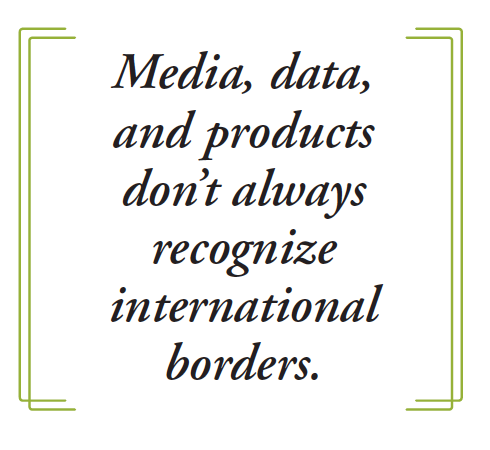Author: Jessica Hawthorne-Castro
Original Link: ER Magazine
Date Published: May – June Issue 2017
 Some 95 percent of the world’s consumers reside outside of the United States, the U.S. Chamber of Commerce says, so the lure of the international marketplace is strong for marketers seeking new customers, business opportunities, and higher revenues. But while thinking beyond borders presents exciting opportunities for anyone wanting to take advantage of the world marketplace, it can also introduce new challenges that can only be addressed through proper planning, forecasting, and strategizing. By preparing for potential roadblocks in advance, marketers can reap the rewards.
Some 95 percent of the world’s consumers reside outside of the United States, the U.S. Chamber of Commerce says, so the lure of the international marketplace is strong for marketers seeking new customers, business opportunities, and higher revenues. But while thinking beyond borders presents exciting opportunities for anyone wanting to take advantage of the world marketplace, it can also introduce new challenges that can only be addressed through proper planning, forecasting, and strategizing. By preparing for potential roadblocks in advance, marketers can reap the rewards.
Recent world events have forced some companies to rethink the way they do business internationally, however. Changing immigration laws, increasingly populist mindsets, and the scrutiny paid to international trade agreements such as NAFTA, for example, are having a collective impact on the way international business is conducted. And while selling overseas remains a viable and profitable opportunity, some of these recent events and decisions could present roadblocks this year and into the future.
Here are four trends all international marketers should keep an eye on this year:
There’s no magic bullet—domestic or international—for cross-channel attribution. Defined by Forrester Research as “the science of using advanced analytics to allocate proportional credit to each marketing touchpoint across all online and offline channels, leading to a desired customer action,” cross-channel attribution is a continuous challenge. That level of complexity doesn’t change when you start doing business overseas; in fact, it multiplies. And while there’s no magic bullet for cross-channel attribution, good analytics can level the playing field and ensure that marketers get the best possible content and information available.
We’re all in a race to develop engaging, trustworthy content. Beyond attribution, the biggest challenges for European marketers surround developing layers of content that are tied to varying cultures, and creating continuous engagement with consumers via social media, blogs, testimonial conversations, trustworthy content, and the capture of key moments in the conversion or conversation funnel.
In the online international marketing magazine The Drum, author Manita Dosanjh recently discussed the obstacles companies face when trying to predict the future in an unpredictable industry. With data privacy and ad blocking posing a threat to how marketers traditionally connect with target audiences, she said, brands will need a better understanding of how to deliver meaningful experiences in the modern customer journey. “This new year won’t be kind to brands who can’t sustain a solid one-to-moment communications approach,” Dosanjh said. “Customers will only stop and focus their attention on a brand if the interaction triggers a genuine emotional connection. And they expect this regardless of how many times they’ve interacted in the past, and irrespective of the channel.”
Global ad spending is rising, but international relations could stall growth. According to eMarketer, global ad spending  grew 7.2 percent in 2016 to $550.5 billion, and it is projected to rise faster than previously expected through 2020. Growth will hover between 5 percent and 9 percent each year, the forecast says, with total spending climbing to $724.1 billion in 2020. Strong demand for digital advertising, and particularly mobile advertising, will be the main driver of spending increases.
grew 7.2 percent in 2016 to $550.5 billion, and it is projected to rise faster than previously expected through 2020. Growth will hover between 5 percent and 9 percent each year, the forecast says, with total spending climbing to $724.1 billion in 2020. Strong demand for digital advertising, and particularly mobile advertising, will be the main driver of spending increases.
Among advertising markets worldwide, the United States led with nearly $196 billion in total media ad spend in 2016—almost 36 percent of the global total. Digital ad spending including mobile increased 20.3 percent to reach $194.6 billion in 2016, making up 35.3 percent of total media ad spending. By 2020, digital spend will top $335 billion and represent over 46 percent of total media ad investment. But whether eMarketer’s growth projections come true will be at least in part reliant on trade agreements and international policies currently under discussion—points that all marketers should watch as the year progresses.
Organizations are taking on global challenges on a case-by-case basis. Earlier this year, Chinese online commerce giant Alibaba filed its first lawsuit over counterfeit goods sold on its site. According to ZDNet, the e-commerce giant sued two vendors for selling fake Swarovski watches on the Taobao marketplace, marking the first time it took legal action against counterfeit sales. And to combat the sale of counterfeit fashion items on its site, eBay recently announced its new “eBay Authenticate” service, which offers professional, independent verification that a product is legitimate in an industry in which Certilogo reports that one in 10 items purchased in the past 12 months was fake. Clearly, the age-old issue of counterfeiting hasn’t gotten any easier to combat in the internet age, but the good news is that some of the largest names in e-tailing are taking a stance against it.
As the global marketplace continues to expand and the internet’s role in that development continues to widen, we expect to see more companies leveraging the world marketplace. Along the way, these companies will face their share of challenges, but they’ll also open themselves to more opportunities and the chance to expand outside of their own borders. So whether they’re trying to wrap their arms around cross-channel attribution, utilize predictive analytics to their advantage, or combat counterfeiters, these companies know and understand that the internet has made our world a much smaller place.
Our agency is working on a cross-border attribution tool to deal with some of these challenges. Since media, data, and products don’t always recognize international borders, it’s up to us to figure out the best approaches for our clients, companies, and trade as a whole.





